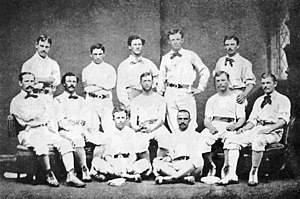
Albert Goodwill Spalding was an American pitcher, manager, and executive in the early years of professional baseball, and the co-founder of A.G. Spalding sporting goods company. He was born and raised in Byron, Illinois yet graduated from Rockford Central High School in Rockford, Illinois. He played major league baseball between 1871 and 1878. Spalding set a trend when he started wearing a baseball glove.
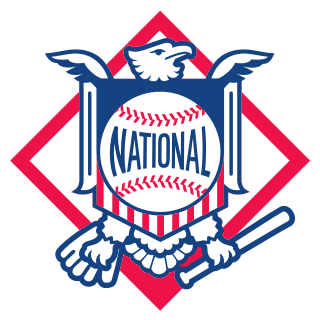
The National League of Professional Baseball Clubs, known simply as the National League (NL), is the older of two leagues constituting Major League Baseball (MLB) in the United States and Canada, and the world's oldest extant professional team sports league. Founded on February 2, 1876, to replace the National Association of Professional Base Ball Players (NAPBBP) of 1871–1875, the NL is sometimes called the Senior Circuit, in contrast to MLB's other league, the American League, which was founded 25 years later and is called the "Junior Circuit". Both leagues currently have 15 teams.
The National Association of Professional Base Ball Players (NAPBBP), often known simply as the National Association (NA), was the first fully-professional sports league in baseball. The NA was founded in 1871 and continued through the 1875 season. It succeeded and incorporated several professional clubs from the previous National Association of Base Ball Players (NABBP) of 1857–1870, sometimes called "the amateur Association". In turn, several NA clubs created the succeeding National League of Professional Baseball Clubs, which joined with the American League of Professional Base Ball Clubs to form Major League Baseball (MLB) in 1903.
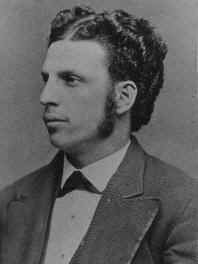
George Wright was an American shortstop in professional baseball. He played for the 1869 Cincinnati Red Stockings, the first fully professional team, when he was the game's best player. He then played for the Boston Red Stockings, helping the team win six league championships from 1871 to 1878. His older brother Harry Wright managed both Red Stockings teams and made George his cornerstone. George was elected to the Baseball Hall of Fame in 1937. After arriving in Boston, he also entered the sporting goods business. There he continued in the industry, assisting in the development of golf.
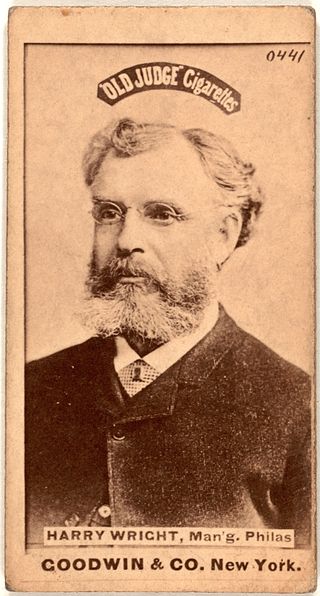
William Henry "Harry" Wright was an English-born professional baseball player, manager, and developer. He assembled, managed, and played center field for baseball's first fully professional team, the 1869 Cincinnati Red Stockings. He is credited with introducing innovations such as backing up infield plays from the outfield and shifting defensive alignments based on hitters' tendencies. For his contributions as a manager and developer of the game, he was inducted into the Baseball Hall of Fame in 1953 by the Veterans Committee. Wright was also the first to make baseball into a business by paying his players up to seven times the pay of the average working man.
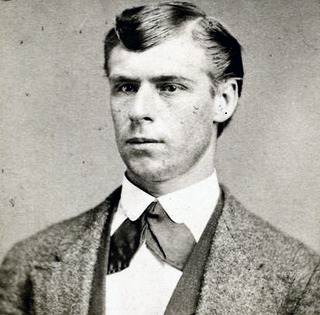
Douglas L. Allison was an American Major League Baseball player. He began his career as a catcher for the original Cincinnati Red Stockings, the first fully professional baseball team. Allison was one of the first catchers to stand directly behind the batter, as a means to prevent baserunners from stealing bases. He was considered a specialist, at a time when some of the better batsmen who manned the position normally rested, or substituted at other fielding positions. Allison became the earliest known player to use a type of baseball glove when he donned buckskin mittens to protect his hands in 1870.
Jefferson Street Grounds was a baseball field located in Philadelphia, Pennsylvania. It was also known as Jefferson Park and Athletics Park. It was home to three different professional baseball teams, competing in three different leagues. Notably, it was the venue for the first game in National League history, played on April 22, 1876.

Calvin Alexander McVey was an American professional baseball player during the 1860s and 1870s. McVey's importance to the game stems from his play on two of the earliest professional baseball teams, the original Cincinnati Red Stockings and the National Association Boston Red Stockings. He also played on the inaugural National League pennant-winning team, the 1876 Chicago White Stockings.

The Atlantic Base Ball Club of Brooklyn was baseball's first champion and its first dynasty. The team was also the first baseball club to visit the White House in 1865 at the invitation of President Andrew Johnson.

George William Hall was a professional baseball player who played in the National Association and later the National League. Born in Stepney, England, Hall later immigrated to the U.S. He made his professional debut on May 5, 1871. While playing for the Louisville Grays, he was banned from Major League Baseball after an 1877 gambling scandal.
The National Association of Base Ball Players (NABBP) was the first organization governing American baseball.
The following are the baseball events of the year 1875 throughout the world.
The following are the baseball events of the year 1874 throughout the world.

Joseph Emley Borden, aka Joe Josephs,, nicknamed "Josephus the Phenomenal", was a starting pitcher in professional baseball for two seasons. Born in the Jacobstown section of North Hanover Township, New Jersey, he was playing for a Philadelphia amateur team when he was discovered by the Philadelphia White Stockings of the National Association (NA) in 1875. The White Stockings needed a replacement for a recently released pitcher, and were awaiting the arrival of a replacement. During his short, seven-game stint with the team, he posted a 2–4 win–loss record, both victories recorded as shutouts. On July 28 of that season, he threw what is thought to be the first no-hitter in professional baseball history.

Robert Edward Addy, nicknamed "The Magnet", was a Canadian right fielder and second baseman in Major League Baseball, whose professional career spanned from 1871 in the National Association to 1877 in the National League. He is credited as the first player to introduce the slide in an organized game, and later attempted to create a game of baseball that would have been played on ice. He is also credited as the first person born in Canada to appear in a major league game.
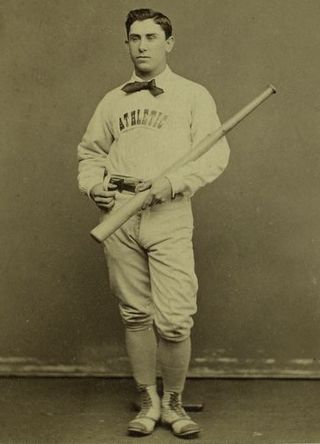
Michael Henry McGeary was an American professional baseball player whose career spanned from 1871 to 1882. He played 11 seasons in Major League Baseball, playing principally as an infielder and catcher, for seven different major league clubs: the Troy Haymakers (1870–1871), the Philadelphia Athletics (NA) (1872–1874), the Philadelphia White Stockings (1875), the St. Louis Brown Stockings (1876–1877), the Providence Grays (1879)–(1880), the Cleveland Blues (1880–1881) and the Detroit Wolverines (1882). Three of those clubs, the Philadelphia White Stockings, Providence Grays and Cleveland Blues, also employed him as player-manager.

John Martin "Marty" Swandell was a German–American baseball player and umpire. He spent parts of two seasons as a player in the National Association (NA), a professional league, and also had an eight-year career in the National Association of Base Ball Players (NABBP), a league with amateur status, between 1863 and 1870.

George Zettlein was an American professional baseball pitcher. He played six seasons in Major League Baseball from 1871 to 1876 for the Chicago White Stockings, Troy Haymakers, Brooklyn Eckfords, Philadelphia White Stockings of the National Association (NA), and the Philadelphia Athletics (1860–1876) of the National League.

John F. McMullin was an American professional baseball player. During the first professional league season in 1871, he was the only regular left-handed pitcher, while in later seasons he mainly played the outfield. After playing almost every game throughout the five National Association seasons (1871–1875), he did not play a single game in the National League that succeeded it. He died in his native Philadelphia five years later, only 32 years old.
